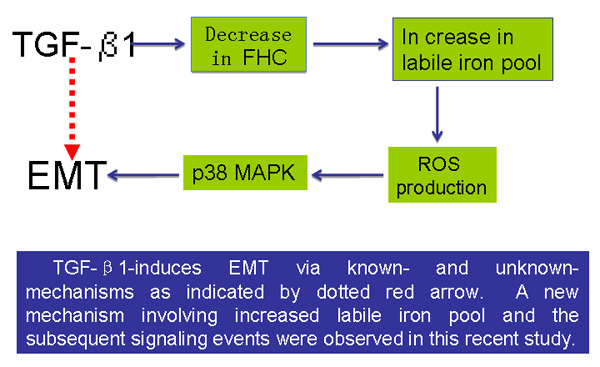A novel finding - Ferritin Heavy Chain–Mediated Iron Homeostasis and Subsequent Increased Reactive Oxygen Species Production Are Essential for Epithelial-Mesenchymal Transition
Source:
Time: 2009-06-30
Research team led by Prof. Jianguo Song and Fukun zhao at IBCB recently discovered that ferritin heavy chain (FHC) – mediated iron homeostasis and subsequent increased reactive oxygen species production are essential or epithelial- mesenchymal transition. Their work was published on Cancer Research on June 16th.
Epithelial-mesenchymal transition (EMT) is a process by which epithelial cells lose epithelial polarity and cell-cell contact and acquire a mesenchymal morphology to become more motile and invasive. It is implicated in embryonic development, wound repair, and fibrotic diseases, contributing to tumor-invasive phenotypes and metastasis.
The research groups of Jianguo Song and Fukun Zhao carried out a comparative proteomic analysis of transforming growth factor-β1 (TGF-β1)-induced EMT in AML-12 murine hepatocytes. They identified a total of 36 proteins with significant alterations in abundance. Among those proteins, FHC, a cellular iron storage protein, was characterized as a novel modulator in TGF-B1-induced EMT. In response to TGF-β1, there was a dramatic decrease in the FHC levels, which caused iron release from FHC and, therefore, increased the intracellular labile iron pool (LIP). In addition, increased LIP levels promoted the production of reactive oxygen species (ROS), which in turn activated p38 mitogen-activated protein kinase. The elimination of ROS inhibited EMT, whereas H2O2 treatment rescued TGF-β1-induced EMT in cells in which the LIP increase was abrogated. Over-expression of exogenous FHC attenuated the increases in LIP and ROS production, leading to a suppression of EMT. Moreover, the study also showed that FHC down-regulation is an event that occurs between the early and highly invasive advanced stages in esophageal adenocarcinoma.
Their results suggested that cellular iron homeostasis regulated by FHC plays a critical role in TGF-B1–induced EMT, which may provides a potential target for therapeutic control of tumor invasion and progression.


 Appendix:
Appendix: